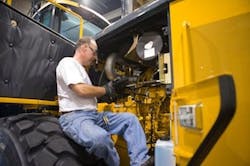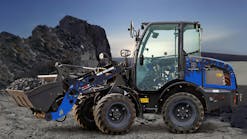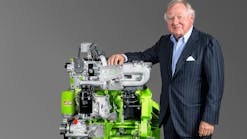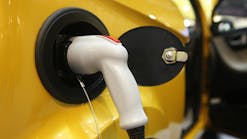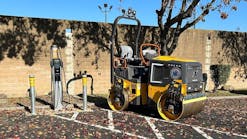Published with permission from Equipment Manager magazine by AEMP.
As 2011 unfolds, Tier 4-Interim engines from 175 to 750 horsepower will make their debut in the off-highway market. Although engines will feature new technologies and hardware in order to meet Environmental Protection Agency (EPA) mandates to reduce atmospheric exposure to harmful emissions, such as soot, they should not pose any major maintenance issues for equipment managers and technicians, according to information obtained from OEM dealers and lubricant executives during recent interviews with Equipment Manager.
Although January was the introductory month, not all models will be introduced at one time, according to Steve Deller, product support manager for Westside Tractor Sales, a John Deere dealer near Chicago.
“For example, if you have 30 models with engines in this particular horsepower range, they won’t hit the market all at once,” Deller says. “OEMs will start the transition with some engines entering the market on January 1 and the rest trickling in throughout 2011.”
Among the reasons a smooth transition is expected is that much of the engine technology and product formulation necessary to meet Tier 4-I have been used since 2007 for on-highway vehicles. That on-road experience is transferable to the off-road market, says Page Gray, off-road segment marketing manager for Castrol Heavy Duty Lubricants.
“Much of that technology will make the transition,” Gray says. “The bigger issue will be fleet managers who want to stick with older engine oil and try to use it in newer vehicles. It will work, but, one, you may not be covered under warranty and, two, you’re going to reduce the life cycle of the diesel particulate filter (DPF) and that will add cost down the road.
“These engine oils have been formulated for an increase of exhaust gas recirculation (EGR),” Gray says. “The newer engines actually pump more exhaust gas back into the engine. When they do that, you are putting contaminants back into the engine. The CJ-4 handles the increased soot load and still allows the fleet to retain extended drain intervals, provided they also use an oil analysis program. In formulating Castrol’s CJ-4 the last thing we wanted to do was have our customers take a step backward. That’s why we spent a great deal of time to engineer premium lubricants that still maintain extended drains. The engine oils that are designed to do exactly that do that.”
For fleet managers toying with the idea of using older oil for older units and the newly formulated CJ-4 oil for the newer engines, Gray says such a move would “add complexity and more risk” to the job of fleet maintenance. CJ-4 won’t hurt the older machine, but old oil in a new machine could void the new-engine warranty.
Alexey Stiop, vice president of research and development for DA Lubricant, agrees. “When equipment managers start purchasing newer units that have DPFs, they need to make a choice. They need to decide whether or not to switch to one lubricant or to have two lubricants. The majority, of course, will prefer to avoid confusion and possible mistakes.”
DPFs and diesel oxidation catalysts (DOCs) will be standard on the new engines, but that should have little impact on fleet managers and technicians who are responsible for maintaining them. In theory at least, DPFs are “very, very automated through on-board management systems as far as regeneration is concerned,” Deller says, “We don’t expect to do any maintenance for the first 4,000 to 5,000 hours if the machine is maintained and operated properly.”
Shaun Manning, technical training director at Holt CAT, says maintenance won’t change much. “From Caterpillar’s side, much of the maintenance for Tier 4-Interim engines will be similar to what fleet managers and technicians are doing today,” he says. “Most manufacturers will require some type of preventive maintenance around 5,000 hours. That’s when the diesel particulate filter will need servicing. Cat’s system is a smart system that is going to take care of the soot itself so technicians won’t have to do anything more than routine maintenance of the DPF to dispose of the ash.”
Indeed, the first additional maintenance point on the new engines will be the DPF.
“You have to clean out the ash load, which is a by-product that the filter cannot regenerate,” Deller says. “Certain high-cycle applications will reach that maintenance point sooner than others, but it’s a ways down the road.”
The operator should monitor the back pressure of the exhaust, Stiop says, and when it reaches a certain value, that means the filter is getting clogged. At that point, the filter can be removed and ash cleaned out.
“You can blow out the ash. There are also special devices that shops can buy which essentially back-pressurize the filter. The device looks like a box that the filter is placed in. “The box collects all the ash that comes out of the filter. The whole job takes about 30 or 40 minutes,” he says.
Servicing the particulate filter is fairly simple, says Deller.
“The ash is a by-product that the filter can’t regenerate. To get rid of the ash, fleet managers have a couple of choices. They can have the filter cleaned locally, if the equipment is available or, two—and I’m speaking only for John Deere–they can bring in the dirty filter and replace it with a remanufactured exchange filter to reduce downtime and ensure that the filter is cleaned to OEM standards.”
Because the residue is particulate ash, both EPA and the California Air Resources Board (CARB) have labeled it as hazardous waste material, says Steve McDonald, whose Deere dealership, Pape Machinery, operates in California.
“They haven’t told us how to handle it yet, but they have told us we should take precautions. So you have to have some type of filtration system to capture all that material to keep it from escaping into the atmosphere.”
The filter-exchange program attracted the attention of more OEMs after CARB loosened up its parameters, McDonald says. Yet there are two schools of thought on swapping out filters.
“You put a swing filter in and you always return the original filter to that unit. That’s one thought. Now CARB allows replacement of the original filter so long as the replacement filter meets its standards. The problem when you do that, however, is that you have to change the serial number in the CARB system to match the filter you’re installing. That’s a lot of clerical work, particularly if you have a large fleet with several units. It may be easier to use the swing filter method, swing it out, do the maintenance and make sure the original filter goes back in. Otherwise, you’re constantly changing numbers.”
In addition to the specialized DPF cleaning equipment or exchange program, a specialized alignment tool will be needed in some cases, according to Deller. The tool ensures the connection between the filter and the exhaust is “absolutely in sync,” he says.
“This will be especially true on higher horsepower machines. With these engines, the filter system won’t be engine-mounted, but will be part of the chassis where you have resonance and engine movement that is independent of the filter treatment system. In most cases, you’ll have a flexible coupling of some nature. The coupling will have to be pretty robust and properly aligned to last a life time. Other than that, you can use basic tools to take the filter cartridge out. It’s readily disassembled with band type clamps or other common securing methods used in our industry.”
McDonald says aftertreatment configuration should depend on machine type and even application. A DPF works most efficiently at full throttle, when the engine burns cleaner at set rpm. In a throttle-up/throttle-down application, a larger filter may be required.
“Each machine has a different set of operating parameters,” he says. “A bulldozer or motor grader will run at a constant rpm for a long period of time. Backhoes and loaders, on the other hand, will throttle up or throttle down. In some cases, you can’t have the same configuration of aftertreatment systems on two different types of machines.
“It is up to the installer to size the unit correctly [for] whatever length the shift is,” McDonald says. “The idea is to prevent the DPF from regenerating in the middle of the day.”
“The DOC pretty much takes care of itself,” McDonald says.
In general, DA’s Stiop says, maintenance is the same as it is today.
“The engines may be tuned a bit differently with a different ECU program, but this will be transparent to the operator. The engines will also probably have prior EGR rates, but again that is something that should be transparent to the operator.”
Although other components in the new engines will require only the usual maintenance, Deller says there could be maintenance points such as crankcase ventilization filters. Low-ash lubes and special coolants will be needed.
“If that’s the case, then that is a second maintenance point,” he says. “Otherwise, the engines will require just regular filters.”
In addition to the change to CJ-4 engine oil, this generation of engines will also require fleets to use ultra low sulfur diesel (ULSD).
“It actually helps with your aftertreatment, if you can get zero sulfur in your fuel—which is the eventual target,” McDonald says.
For fleets operating across borders, the low sulfur fuel and lubricants have created yet another obstacle, McDonald says.
“The problem we’re having right now is that ultra low sulfur diesel isn’t available in Mexico. Contractors in border states like Arizona and southern California have machines that sometimes go across borders. Since the new engines are designed to run on ultra low sulfur diesel, a machine that ends up in Mexico can’t use local fuel. In a situation like that, ultra low sulfur diesel has to be imported to run the machine. Those guys have another whole set of problems.”
DA’s Stiop says ULSD also helps offset losses in corrosive protection imposed on the new lubricants. Chemical limits on CJ-4 engine oils affect the anti-wear additives as well as metallic detergents, the carriers of total base number (TBN), an important property that controls corrosive acids. Engine oils would typically have a TBN between 11and 14; the highest TBN of the new lubes is around 10. “That is a significant reduction,” Stiop says.
“Fortunately, what counteracts this risk of acidic corrosion of the engine parts is that all diesel fuel now has been switched to ultra low sulfur,” he says. “Two acids are produced during combustion. One is sulfur that is sourced from diesel fuel. As we go forward that source has been drastically reduced.”
The other source is atmospheric nitrogen, “which no one can control,” he says. “It stays constant no matter what. As power loads increase and EGR rates increase, unfortunately formation of NOx and their impact on the engine increases. That is something that still needs to be dealt with.”
Being able to retain extended oil drain intervals while using CJ-4 lubricants in conjunction with used-oil analysis came as an initial surprise to both on-road and some off-road fleets.
“The results have been positive,” Stiop says. “We originally anticipated that with OEM recommendations, drain intervals for this type of oil would be reduced. Now we’re finding that some fleets have been able to maintain their extended drains with the help of used-oil analysis programs.”
When ultra low sulfur fuel was introduced initially it was supposed to be phased in gradually, Stiop says, with a gradual transition moving from the on-road market to off-road
“But since the majority of fuel is delivered by pipeline, what happened was that the switch to low-sulfur fuel was done faster than EPA required because it is very difficult to switch from one type fuel to another. To avoid that expense, suppliers went straight to low sulfur fuel. Today, non-low sulfur diesel is very difficult to come by.”
For the past couple of years, low sulfur fuel has become commonplace and both on- and off-highway fleets have experience with it, Stiop says. “They have learned to deal with some of its maintenance aspects.”
The newest development on the fuel front that will affect fleet managers is urea, which is showing up in the on-road market for the first time this year. Urea will be required for the off-highway market when the Tier 4-Final engines are mandated in 2014, although some engines today may require it.
“Urea is a diesel emission fluid that many OEMs will use to achieve final Tier 4 requirements,” Westside’s Deller says. “Urea is a liquid that is introduced into the exhaust stream to reduce NOx output of the diesel engine.”
Urea is a unique liquid, he says. “Its gel point is about 14F, at which it won’t flow any longer. By the same token, urea becomes unstable at temperatures over 112F. It becomes cloudy and starts to separate. So, we need to look at ways to store it.
“I think what you’re going to see is on-road technology helping us make a smoother transition to the off-road applications,” Deller says. “On-road technology will develop so that truck stops eventually will have a urea pump right next to a diesel pump as well as having packaged quantities available at our dealerships and other outlets. It will become more and more readily available and soon will become second nature.”
Stiop concurs. “Enough people jumped on the wagon with urea early on because it is a very good business to be in. Cost to produce it is very low, and it is simple to produce, so the profit margins are there. Urea is definitely going to be available, although originally people worried about the infrastructure to carry it. But if there is a demand, they don’t need to worry. There will be infrastructure.”
Equipment managers won’t have to fill up the urea tank every time they buy fuel,” Stiop says. “It has been the experience of on-road fleets that urea tanks are smaller, yet typically on-road vehicles can go coast-to-coast and maybe even more on one charge. That can be easily monitored and maintained at maintenance facilities.”
McDonald says urea may present fleets with problems.
“The trucking industry has experience with urea and they seem to be handling it just fine. As for what fleet managers should know about it, the numbers I’ve heard are three gallons of urea for every 100 gallons of fuel, depending on the engine and what it is doing. The biggest issue is distribution. Contractors will have to carry another fluid, and urea is a hazardous material. That’s just another thing they’ll have to deal with.”
When urea freezes, he says, the fluid expands upward, not outward. “When it freezes it is not like water that expands in all directions. Urea expands upward. Therefore the volume of the storage tank must be controlled in order to refill it. For instance, if it does freeze and you pour warm urea on top of it, how is that going to affect it? No one knows.”
Manning described the January 2011 introduction of Tier 4-Interim as similar to the computer industry’s concern with the year 2000.
“It’s going to be almost a nonevent,” he said. “Caterpillar has trained its sales and service people to be prepared for the change. Cat learned a lot from its on-highway product and has been training personnel to maintain and adjust Tier 4 technology since March 2010.”
Despite the unknowns and the learning curve some fleet managers may have in dealing with the new breed of engines, equipment distributors and lubricant suppliers can prove to be an effective bridge to use during the transitions.
“Equipment distributors and OEMs...are on the cutting edge of this technology right now,” McDonald says. “All of them have Tier 4 engines in the works. Although Interim Tier 4 appears on the market in 2011, the bigger horsepower engines that come later present more of a challenge.”
At Westside Tractor, says Deller, “We offer a series of educational events at dealerships to discuss Tier 4, talk about what’s coming, and update contractors on emissions regulations that have been adopted. We do this so fleet managers can understand how to prepare their fleets, how to look ahead and prepare for some of the challenges they are going to face.”
Castrol’s Gray says suppliers need to step up. “It’s up to all of us to bring this information forward because a lack of knowledge may cause fleet managers to fill in the blanks with all the worst scenarios. We have to let fleet managers know what’s happening, what to expect, and demonstrate what our experience over several years with this technology in the on-road markets has taught us, and that it’s working.
“We have to let them know that they are not necessarily guinea pigs. They can focus on their business and trust us to deliver products they don’t have to worry about.”
